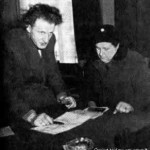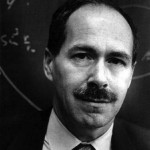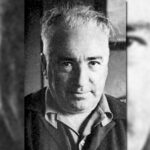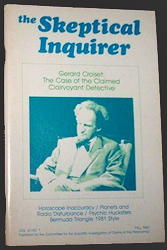 The following two articles were published in the Skeptical Inquirer, the official journal of the Committee for Skeptical Inquiry (CSI). Author Piet Hein Hoebens (1948-1984) was an investigative journalist with the Dutch daily De Telegraaf, and a member of the Dutch section of the Committee for the Scientific Investigation of Claims of the Paranormal (as CSI was called before 2006).
The following two articles were published in the Skeptical Inquirer, the official journal of the Committee for Skeptical Inquiry (CSI). Author Piet Hein Hoebens (1948-1984) was an investigative journalist with the Dutch daily De Telegraaf, and a member of the Dutch section of the Committee for the Scientific Investigation of Claims of the Paranormal (as CSI was called before 2006).
Gerard Croiset: Investigation of the Mozart of ‘Psychic Sleuths’ – Part I, Skeptical Inquirer , vol. VI no. 1 (Fall 1981) pp. 17-28
Croiset and Professor Tenhaeff: Discrepancies in Claims of Clairvoyance, Skeptical Inquirer vol. VI, no. 2 (Winter 1981-82) pp. 32-40
NB images in this online version are different from the ones in the original publications.
Gerard Croiset
Investigation of the Mozart of ‘Psychic Sleuths’ – Part I
Critical examination of the evidence surrounding the cases of supposed crime-solving by the celebrated Dutch “clairvoyant” finds extraordinary differences between the claims and the facts.
by Piet Hein Hoebens
First of two articles.
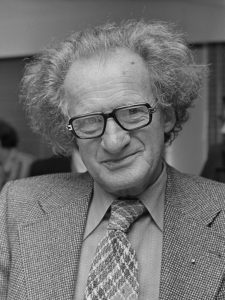
The Dutchman Gerard Croiset, who died unexpectedly in July 1980, was undoubtedly one of the psychic superstars of the twentieth century. His mentor, Professor Wilhelm Tenhaeff, has called him the clairvoyant equivalent of Mozart or Beethoven. Tenhaeff’s German colleague, Professor Hans Bender, recently admitted that Croiset had been instrumental in transforming his belief in ESP into “an unshakable conviction.” The obituaries published in the European press reflected the sensitive’s unique reputation. According to the Amsterdam weekly Elsevier, the deceased had heralded a “new awareness of cosmic solidarity.” The German parascientific monthly Esotera ran a cover story lamenting the death of “the clairvoyant who never disappointed.” A professor from the papal university delivered the funeral oration.
Croiset’s career in the supernatural has been distinguished indeed. According to his biographers, he has solved some of the century’s most baffling crimes, traced countless lost objects, and located hundreds of missing persons. His paranormal healing powers are said to have been on the Caycean level. He “excelled” at precognition and is credited with having accurately foretold future events on numerous occasions. Most of his remarkable feats, it is said, were performed under scientific supervision, which supposedly would make Croiset one of the most thoroughly tested sensitives since Mrs. Piper.
Gerard Croiset was respectable. Many educated Dutchmen who profess disbelief in ESP have managed to hold the simultaneous conviction that Croiset, for one, was genuine.
This miracle man is the subject of a full-length biography by the American journalist Jack Harrison Pollack, who claims to have spent five years checking and double-checking the psychic’s record. Pollack’s verdict: “Unbelievable, but true.” Unbelievable, indeed. But true?
Psychic Detectives
The practical achievements of Gerard Croiset and other sensitives who claim to assist the police share most of the features of “spontaneous cases.” (1) Such cases typically occur under uncontrolled conditions and are by their very nature unrepeatable. This means that the only evidence we have usually consists of whatever witnesses are able to remember or care to report. Before reaching a verdict, the critical investigator has to address two crucial questions:
- Are the reports free of omissions, errors, and deliberate distortions?
- Does whatever remains after the first question has been answered admit no more plausible an explanation than ESP?
The Sources
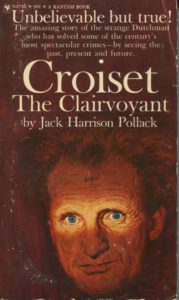
Studying Croiset has been the virtual monopoly of Wilhelm Heinrich Carl Tenhaeff, the Dutch parapsychologist who in 1953 was appointed to the first chair of psychical research ever to be established at a regular university (Utrecht). Tenhaeff’s books and articles constitute the principal source of information on Croiset, whose case may be said to stand or fall with the reliability of his learned mentor. Unfortunately, little of Tenhaeff’s work has been translated into English, which leaves Pollack’s Croiset the Clairvoyant as the main reference in this language. Pollack is a journalist, not a scholar. Yet his biography may be regarded as an authoritative document, since it was written under the personal guidance of Tenhaeff himself. “He indefatigably double-checked the facts in my manuscript,” Pollack states in his Acknowledgment.
In Tenhaeff’s Tijdschrift voor Parapsychologie (the official journal of the Dutch Society for Psychical Research), the professor has proudly confirmed this. According to Tenhaeff, Croiset the Clairvoyant “was written on the basis of information which I supplied and also under my supervision.”
Police Records
According to Pollack, Croiset won plaudits not just from parapsychologists but from policemen all over the world for his achievements in psychic detection. “I checked documents in case after case in police records,” the biographer assures us. I am not quite certain what he means. Most of the documents he refers to must have been in Dutch, and I doubt that he ever familiarized himself with the language. The only Dutch expression I found in the book is the equivalent of “thank you,” and even that solitary example contains an error. Presumably, Pollack relied on summaries or translations of the relevant documentation, prepared for him by Tenhaeff and other acquaintances in the Netherlands. He must have felt it was quite safe to do so. After all, his material would be double-checked by a distinguished scholar, a professor at a state university, a pioneer whom the American psychiatrist-parapsychologist Dr. Berthold Eric Schwartz had compared to Copernicus, Freud, and Einstein.
The Boy on the Raft
It is time to take a closer look at one of Croiset’s most impressive successes. It is the “Boy on Raft” case, and will be found on pages 106 and 107 of the Bantam paperback edition of Croiset the Clairvoyant. This case has often been mentioned in the psi literature, and Tenhaeff himself has indicated more than once that it is one of the classics.
This is how Pollack reports it (italics added):
Ten-year-old Dirk Zwenne left his home in the dunes city of Velsen near the North Sea canal on Saturday, August 29, 1953, at about two P.M. to play. When the boy had not returned home by early evening, his parents began to grow uneasy. They telephoned the local police without success. When no trace of the missing boy had been found in two days, Dirk’s uncle telephoned Croiset, whose phone number and address in Enschede, 115 miles away, had been given to him by a police superintendent. Among the clairvoyant’s immediate images was that Dirk had drowned: “I see a small harbor, a small raft and a little sailboat. The boy was playing on the raft. He slipped and fell into the water. As he fell, his head struck the sailboat and he received an injury on the left side of his head. I am very sorry. There was a strong current in the harbor. The boy’s body will be found in a few day’s in another small harbor which is connected with the first harbor.” Unhappily, five days after he had disappeared, the body of Dirk Zwenne was found in this second harbor. And, just as Croiset had seen, the boy had a wound on the left side of his head. The raft and small sailboat were recovered in the first harbor – again just as the sensitive had described. “It is very likely that everything had happened as the paragnost had seen it,” summarized Professor Tenhaeff.
This seems a striking case indeed. Oddly enough, until now nobody seems to have thought of comparing this version with a letter that was published in Tijdschrift voor Parapsychologie in 1955 (vol. 23, no. 1/2). It was written by Mr. A. J. Allan, the uncle who had consulted Croiset. From this report (embedded in an article by Tenhaeff) we get an idea of what really happened. On Monday, August 31, Mr. Allan phoned the clairvoyant, who was at that time living in the eastern Dutch town of Enschede. He acted on the advice of Haarlem police superintendent Gorter, who happened to be the second secretary of the Dutch Society for Psychical Research (SPR) and an acquaintance of both Tenhaeff and Croiset.
The sensitive, after having made clear that he knew what the call was about, told the uncle: “You must look near a gasholder.”
Allan: “A gasholder?”
Croiset: “Yes. It might be a tank or a boiler or something like that. I see a road and a small ditch. I also see a small bridge and a small water. Do I speak to the boy’s father?”
Allan: “No, you are speaking to an uncle.”
Croiset: “All right, I can speak freely. The child has drowned. He is dead. I also see a jetty and a rowing boat or something like that. That’s where the body must be.”
Allan: “Could it be the North Sea Canal?”
Croiset: “No, that is too broad. I don’t see so much water.”
Allan: “Then where is it?”
Croiset: “I don’t know Velsen, but you have to look near that gasholder or tank. It is to the right of it. To know for sure I ought to come to Velsen. Call me again if that’s necessary.”
End of conversation.
Holland being a country full of roads, ditches, small bridges, small waters, jetties, rowboats, and objects that could be described as gasholders, tanks, boilers, or “something like that,” Croiset’s impressions had hardly been specific. His description could apply to any number of locations.
According to Mr. Allan, the police, “after having considered several possibilities,” decided that Croiset must have “seen” a small harbor near a water purification plant. This is a rather surprising interpretation, as that “harbor” (really a recess) is part of the North Sea Canal. The psychic had been specific on only one point: the water was not the North Sea Canal. To me, this strongly suggests that the police had reasons of their own to regard the small harbor as a likely place.
The police decided to drag the harbor the next day. On Tuesday, they heard that Dirk, shortly before disappearing, had told one of his friends about “having found a nice raft.”
Croiset, who was phoned again later that day, now started to receive impressions of a raft also. Mr. Allan suggests that this was due to telepathy, but the skeptical reader may be able to think of a more naturalistic explanation.
Nothing was found in the small harbor, and the next day Allan asked Croiset to come to Velsen. The clairvoyant arrived that same evening, in the company of Tenhaeff.
The psychic was taken to the small harbor, and there he started to get “strong emotions.” He stated that the boy had been playing with his raft, had lost his balance, and had bumped his head on a hard object. “According to him [Croiset] this had been fatal.” Allan notes. Croiset predicted the body would not be found before Monday, September 7, or Tuesday the 8th, and would show an injury “on the left side of the forehead.” The clairvoyant was then taken to a second small harbor that also forms part of the North Sea Canal. There, however, he felt “no emotions.”
The next morning, Thursday, September 3, the body of Dirk Zwenne was found in the canal near the entrance of the second harbor. The head showed bruises, but not at the location Croiset had indicated. Where and in what circumstances the boy had fallen into the water appears never to have been ascertained.
Now please compare this long and tedious story with Pollack’s “summary” and be surprised at the magical metamorphosis an entirely unspectacular event has undergone in the process of summarizing. Croiset’s impressions had been vague and for the most part wide of the mark, and yet this case is cited as a classic instance of successful psychic detection.
How could this fantastic distortion ever have survived the checking and double-checking by an experienced American journalist and a distinguished university professor? The answer to this question may contain the key to much of the Croiset mystery. For it was Tenhaeff himself who concocted the fake version. Having published Allan’s account in his Tijdschrift, destined for the home market, the professor prepared a special version for export.
All Pollack had to do was to paraphrase the version Tenhaeff had already published in German (Zeitschrift für Parapsychologie und Grenzgebiete der Psychologie, vol. 2, no. 1, 1958) and in English (Proceedings of the Parapsychological Institute of the State University of Utrecht, no. 1, December 1960). This latter version reads as follows:
When no trace of the child had been found by 31st August an uncle of the missing child rang up Mr. Alpha [Croiset’s code name], whose name and address he had obtained from a police superintendent. According to the paragnost the child had drowned. Among the “pictures” which presented themselves to Mr. Alpha were a few which concerned a small harbour. In this small harbour he “saw” a small raft and a little sailing boat. According to the paragnost the child had been playing on the raft. He supposed him while at play to have slipped and to have fallen into the water. In doing so he appeared to have incurred a wound on the left side of the head where he struck the sailing boat as he fell. In consequence of a current in the harbour, so the paragnost said, the body would be found in another small harbour which was connected with the first. On 3rd September, just as the paragnost had “seen,” the body of Dirk Zwenne was in fact found in the second harbor with a wound on the left side of his head. [Italics added.]
On all essential points, this version is identical to Pollack’s. In this form, the “Boy on Raft” case has become the “believer’s favorite.” It was featured in the cover story devoted to Croiset in the September 1979 Holland Herald (an English-language magazine mainly concerned with “selling” the Netherlands) and found its way into Ryzl’s Parapsychology: A Scientific Approach and numerous other publications. It is clear that in this case, Professor Tenhaeff “cooked the books.” His probable reasons for doing so will be discussed later.
Pollack as a Witness
Jack Harrison Pollack can hardly be blamed for the serious errors in his report of the “Boy on Raft” case. A journalist may be forgiven for accepting a university professor’s word, but he must be held responsible for his reports of what he claims he personally witnessed.
In This Week of February 19, 1961 (a slightly elaborated version will be found on pp. 25-26 of the paperback edition of the biography), Pollack recalled being present when, on May 21, 1960, Croiset was phoned by a neighbor of an Eindhoven family whose four-year-old son had been missing for 24 hours. According to the article, the police “had no clues.” “The outlook isn’t good,” Croiset is quoted as saying. “Search the area immediately. But I’m afraid in about three days the child’s body will be found in the canal close to the bridge.”
Pollack continues: “Three days later, I checked up. The police of Eindhoven had just found the child’s body next to one of the piers of the bridge over the canal – exactly as Croiset had predicted.”
Something seems to have gone wrong when Pollack checked up. In 1981, I made inquiries with the Eindhoven police. Mr. W. Jongsma of the Information Office kindly offered to check the original police report. These are the real facts: The victim, three-year-old Anthonius Thonen, while playing with a friend, fell into the Dommel River on May 20. The accident was witnessed by the other boy, who told Anthonius’s mother about it when she came looking for him. Mrs. Thoonen saw something floating on the water. Presumably, this was the body. It had disappeared when the police arrived. On May 23 (two days after the telephone conversation), Anthonius’s remains were found in the river, near the Gessel playground.
The police report does not mention Croiset. Neither does it mention a bridge. (There are so many bridges over the Dommel that there is always one nearby.) The authorities from the very beginning knew that the boy had drowned in the river. Pollack’s claim that the police “had no clues” is utterly misleading. No one needed a clairvoyant to say that “the outlook isn’t good” or that the area should be searched immediately. Yet, by overlooking some crucial facts, Pollack is able to present this case as “an amazing demonstration.”
Search for a Child
Pollack’s book and numerous other English-language publications convey the impression that psychics are employed as a matter of course in Dutch police investigations. Some journalists seem to think that a special hot-line connects Tenhaeff’s office with police headquarters in every major town. Perhaps the language barrier may have been responsible for this exaggeration. In fact, Dutch police authorities tend to be skeptical of clairvoyants. Their typical reply to questions about Croiset is something to the effect that ESP may exist but Croiset was never of any use to them. However, there are a few exceptions.
Notable among the exceptions is a report by Inspector G. D. H. van Woudenberg, published in Algemeen Politieblad (no. 13, 1964, pp. 297-300). Van Woudenberg, at that time serving with the Voorburg police, relates an apparent success Croiset achieved in searching for the body of six-year-old Wim Slee. The child was reported missing on April 11, 1963. A thorough search was organized the same day. A police dog led the way to a certain spot on the bank of a canal locally known as De Vliet. There were good reasons to assume the dog was right, as it was known that Wim often went there to play. Nobody was found, however. The next day the case was mentioned in the press and on radio and television. A number of psychics volunteered with perfectly worthless information. In the meantime, an uncle had rung Croiset’s phone number, to be told that the psychic had gone abroad. The uncle did not get through to Croiset until the 16th. The clairvoyant then told him that the boy had drowned in De Vliet. The body would surface in a couple of days near a bridge, a sluice, “or something like that,” to the left of the spot where the accident had happened. Croiset asked to be called back in case the child had not been found by Friday the 19th.
That Friday, with still no trace of Wim Slee, Croiset came to Voorburg. He had with him a sketch of the location where the boy had fallen into the water. He invited the police to get into his car and then drove to De Vliet. He stopped near the spot indicated by the dog and stated that he now experienced “strong emotions.” Van Woudenberg noted “striking similarities” between the sketch and the actual location. Croiset said the child had drowned there but would surface on Tuesday morning near a bridge some 800 yards downstream. This was to the right of the indicated spot (as seen from Voorburg), but the clairvoyant explained that “to the right” really is the same as “to the left” if you look at it from the other side. Near the bridge, van Woudenberg continues, “we saw there were points [on the sketch] that corresponded with what the uncle had been told earlier that week.”
As it happened, Wim Slee’s body was found the following Tuesday near the bridge. Presumably, the remains had been tangled up in refuse on the bottom of the canal.
Unless we want to make unfounded conjectures about a possible lapse of memory on van Woudenberg’s part, the verdict must be: a hit. Yet I wonder if ESP is the only plausible explanation. Croiset gave his first “impressions” on the 16th, five days after Wim Slee had been reported missing. The case had received considerable media coverage. The police suspected that the boy had drowned in De Vliet and the dog had even indicated a likely spot. However, Croiset’s initial “images” were vague, and he did not specify what bridge, sluice, or “something like that” he meant.
His description (as reported by van Woudenberg) would fit a good many bridgelike structures. He stated that the body had floated “to the left” but did not say from what vantage point. Moreover, from his request to be called back in case the body was still missing on Friday the 19th, we may surmise that he expected that the boy would have been found by that date. Friday the 19th would have been eight days after Wim Slee disappeared, and van Woudenberg tells us that “most bodies come to the surface in a maximum of nine days.”
Croiset scored a hit only when he tried again. The accuracy of the sketch he showed on the 19th is not surprising. He had simply drawn the area where, according to the police dog, the child had fallen into the water. The possibility that he had obtained his information by normal means should not be ruled out. Van Woudenberg (personal communication) thinks this hypothesis somewhat unlikely, as the sketch contained a few details of the location not visible from the public road. I venture to suggest that the inspector may have underestimated the resourcefulness of a highly experienced psychic.
What remains is that Croiset, in his second series of “impressions,” received eight days after the accident, correctly predicted both the date and the spot where the body would be found. Striking enough, but I doubt whether the odds against such a hit arising from chance alone are really astronomical.
Van Woudenberg (personal communication) is still impressed by Croiset’s success, although he does not think it falls into the “conclusive evidence” category. “The weakest part of the case,” he told me in February 1981, “is that it seems to be pretty unique. It happened 17 years ago and continues to be cited as possibly the best case that ever happened in Holland. One cannot help wondering why there seem to be so few comparable successes.”
Failures
As an isolated case, Croiset’s achievement in Voorburg is fairly impressive. However, we must guard against a common fallacy in assessing such apparently compelling “proofs.” The chance hypothesis can only be ruled out if we know the hits miss ratio in the psychic’s total score. On this point, no statistics are available, but there are a number of reliable indications. In his English-language Proceedings (1960) and in a number of other publications, Tenhaeff has admitted that the number of successful consultations (successful from a practical point of view) is limited. The bulk of the material in his Beschouwingen over het gebruik van paragnosten (1957), his major Dutch work on psychic detection, concerns cases where the psychics supposedly demonstrated ESP without actually solving any crime or finding any missing person. There are very few prize cases, and these are cited time and again. Some of these “successes,” as I have shown, are striking only when the facts have carefully been doctored. In his book Ontmoetingen met Paragnosten (“Encounters with Psychics,” 1979) Tenhaeff quotes Croiset as stating that he was consulted by relatives of missing persons on an average of 10 to 12 times a week. That is something like 500 times a year, and Croiset has been in the business since the forties! All this strongly suggests that thousands of Croiset’s attempts have ended in failures – even if we generously use standards that allow, for example, the “Boy on Raft” case to be judged a success. Given so many misses, an occasional lucky hit is hardly surprising. The miracle van Woudenberg thought he witnessed may simply have been one of those successful guesses we can expect once in a while if the number of trials is sufficiently large. Tenhaeff is remarkably reticent about the many failures, except when he feels able to explain them in terms of misdirected ESP. The complete disasters that cannot be rescued even by parapsychological special pleading are conveniently ignored. Examples, however, are numerous. In May 1956 the public prosecutor in Amsterdam revealed that three psychics had earlier that year attempted to shed light on the disappearance of a 31-year-old inhabitant of Rossum. Croiset had stated that the man was alive and staying in Germany. Shortly thereafter, the body was found in a canal in the municipality of Ootmarsum, Holland. (2)
In 1969, Croiset went to Viareggio, in Italy, to look for 13-year-old Ermano Lavorini. He “saw” that the boy had fallen into the water while playing. In fact, Ermano had been killed by a friend during a quarrel. The body was found in the dunes.
In 1966, Croiset journeyed to Adelaide, Australia, to search for three missing children. A local “committee” paid the expenses. The clairvoyant was sure the children were buried under a new warehouse. He advised demolition. The “committee” collected 40,000 Australian dollars to have the building pulled down. The soil under the concrete floor was removed to a depth of four yards. No bodies were found. Croiset urged them to dig one more yard, “and the children will be found.” He was wrong. This costly mistake did not affect his reputation. Three years later the Amsterdam paper Het Vrije Volk, quoting an AP Telex, claimed that the Australian authorities had “refused permission to search on the spot.”
In June 1973, Croiset was consulted by the relatives of a murdered Chinese from The Hague. The clairvoyant indicated that a Mr. Senf knew more about the crime. The relatives then abducted Senf and tortured him for three hours to get a “confession.” Senf, however, had nothing to confess. He happened to be innocent. The following week, Croiset visited Senf, who was in the hospital recovering from his ordeal. He brought flowers and assured Senf that he now was quite convinced of his innocence. In the police journal Algemeen Politieblad of January 9, 1960, Utrecht Superintendent Th. van Roosmalen published a catalogue of psychic blunders. In December 1957, he revealed, the 14-year-old son of the E. family disappeared from his parental home in the Utrecht River district. (3) The house was near one of several canals in that part of town. After a couple of days, the parents contacted Croiset. The psychic came and led Mr. and Mrs. E. to the quay, where he stopped and pointed. “This is where your son got into the water and drowned,” he said. “I am desolate that I have to be the first to offer you my sympathy for having suffered such a grievous bereavement.” The police learned from neighbors that the parents next day had contacted an undertaker to arrange for the funeral. A few days later the boy was found, alive and well and hiding in a haystack.
In the light of such occurrences – and I could quote many more – Esotera’s description of Croiset as “the psychic who never disappointed” seems to contain an element of poetic license. (4)
Notes
- This article and the one to follow are exclusively concerned with Croiset’s activities as a paranormal sleuth. In that role he became best known abroad. About the experiments with him I will have more to say later.
- Probably meant is: Rossum in Overijssel. Ootmarssum and Rossum both are now part of a larger municipality (Dinkelland) and Rossum and Ootmarsum are 10 and 5 kilometers respectively from the German border. Note added for the Skepsis website.
- Probably meant is the Rivierenwijk, a part in the south east of Utrecht near the Rijnlaan where most streets have names of Dutch rivers – such as Dommelstraat. Note added for the Skepsis website.
- While this article was in press, we were informed that Professor Tenhaeff died on July 9, 1981. Professor Tenhaeff had received prior notice of the results of Mr. Hoebens’s investigations but declined several invitations to offer specific counterarguments. – Ed.
Croiset and Professor Tenhaeff
Discrepancies in Claims of Clairvoyance
It appears that Professor Tenhaeff, whose works are the principal source of information on the Dutch clairvoyant, fraudulently reported his results
by Piet Hein Hoebens
This is the second of two articles on Hoebens’s investigations. The first appeared in our Fall issue. – Ed.
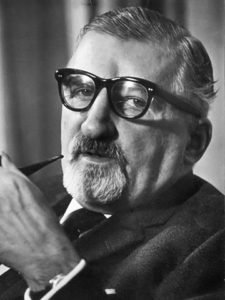
According to Professor Wilhelm Heinrich Carl Tenhaeff (Proceedings 1960), the majority of the hits scored by “psychic” detectives “appear to be of value solely from the parapsychological angle.” They are of no use to the police, but to the experienced psychical researcher they constitute interesting examples of ESP. The psychic is supposed actually to have “seen” particulars relating to a given police case but to have been unable to get his vision into focus. Only post factum can the clairvoyant’s impressions be declared hits. This, however, requires the facts to be subjected to a positively procrustean form of “interpretation.”
An anecdote cited by American journalist Jack Harrison Pollack is an almost burlesque example of the lengths to which determined believers will go to make the outcome fit the prediction. Pollack is the author of a full-length biography of the Dutch clairvoyant Gerard Croiset, which Tenhaeff helped him with and vouched for. Consulted in a 1950 Arnhem rape case, Croiset “saw” that the rapist had “an abnormally big genital organ.” When the police arrested a suspect, they had a good look at his private parts but found them to be standard size. Never mind, says Pollack, “They learned that he was a twenty-year-old cook who occasionally used a big, red basting syringe in the kitchen, which prompted Croiset’s image of an abnormally large genital organ.”
Both in the police cases and in the experimental “chair” tests, Croiset’s typical ESP hit was on a comparable level. Of course the common willingness to believe that a post factum “explanation” reveals what the psychic really meant in the first place is at the bottom of the astounding success of hundreds of soothsayers, I Ching experts, tea-leaf readers, and other augurs. Tenhaeff, however, thought that those who make this objection suffer from “Gestalt blindness.”
Professor Tenhaeff, who in 1953 was appointed to the first chair of psychical research ever to be established at a regular university (Utrecht), had a virtual monopoly on the study of Croiset. Tenhaeff’s books and articles constitute the principal source of information on Croiset, and it may be said that the case for Croiset’s clairvoyant abilities stands or falls with the reliability of his learned mentor. (Tenhaeff died on July 9, 1981, while this two-article series was in press. Professor Tenhaeff had received prior notice of the results of my investigations but declined my invitation to offer specific counterarguments.)
Critics
Th. van Roosmallen is not mentioned in Pollack’s Croiset the Clairvoyant and neither are several other authors who have occasionally cast doubt on the psychic’s achievements and their documentation. In the index to Pollack’s book, one looks in vain for such names as George Zorab, the parapsychologist who first discovered Croiset and who could have told Pollack some interesting facts about both the psychic and the professor; Spigt, the historian who showed that Tenhaeff’s inaugural address in 1953 was based entirely on a spurious source; Filippus Brink, the criminologist who wrote a major work on occult detectives; Pelz, the Hamburg police officer who in 1959 published a scathing report, titled “Herr Croiset, You Are Not Psychic”; and Ph. B. Ottervanger, the Dutch skeptic who in the fifties fired many a well-aimed shot at Tenhaeff and his protégé.
Pollack may never have heard of these critics; presumably Tenhaeff did not encourage him to contact them. They might have persuaded the American journalist to correct at least a few of the most outrageous errors in his manuscript and to include some material that, while not flattering to the subject, might have improved the book.
In the same This Week article that we find the Eindhoven case (described in Part I of this series), Pollack praises Tenhaeff as “a stickler for complete scientific proof.” Similar laudatory phrases are found in the biography. Pollack might have given a different description had he been familiar with van Roosmalen’s article in Algemeen Politieblad. There, the Utrecht superintendent reports his meeting with Tenhaeff, which was arranged by the judge-commissioner in Utrecht. On that memorable occasion, van Roosmalen flatly told the professor that he did not believe in paranormal sleuthing. “Superintendent,” Tenhaeff replied, “If you like, I will tell you of a few cases where the police failed and where Croiset was successful.” Tenhaeff then related, in great detail, two ironclad cases. The first concerned a murder in the municipality X. After months of fruitless investigation, the police consulted Croiset. The psychic gave such a clear description of the murderer that they were able to make an arrest. The second case concerned a theft in a factory in the town of Y, where Croiset had identified the thief.
Van Roosmalen decided to check these claims. The police officer in X, when asked about the murder case, was puzzled. He said it was somewhat unlikely that Croiset had been successful in identifying the murderer because they had no record of such a crime having been committed! Van Roosmallen’s colleagues in Y admitted that a suspect had been arrested on Croiset’s advice. However, the alleged thief proved to be entirely innocent and had to be released with profuse apologies. Van Roosmalen was urgently advised not to mention the name of Croiset if he should visit the police in Y.
Pollack might also have found an interview with Filippus Brink enlightening. Brink, a police officer, in 1958 completed a doctoral thesis, Enige aspecten van de paragnosie in het Nederlandse strafproces (“Some Aspects of ESP in the Netherlands Criminal Proceedings”), in which he reported the results of a series of experiments with occult detectives and of inquiries to police authorities in both Holland and abroad. Brink had tested four well-known “psychics” – one of whom was Croiset – by handing them photographs and other objects and requesting them to give their “impressions.” Some of the materials were related to police cases, others were not. The experiments were extensive and lasted for more than a year. The results were nil. Looking at the picture of a murderer, the psychics clearly saw that the man was innocent; handling a weapon that came straight from the factory, they got visions of murder and hold-ups.
In “Aid to the Police,” one of his few articles published in English (Tomorrow, Autumn 1953), Tenhaeff had assured his readers that Croiset “does not ‘fish’ for information.” Brink observed nothing but fishing.
The results of Brink’s police department inquiries were hardly more comforting to the proponents of paranormal detection. With very few exceptions, all Dutch and foreign authorities stated that psychics had never been successful in furthering any police investigation. (Incidentally, this was the reply even from the Haarlem police district, where Mr. Gorter had been superintendent. See Part I.) The exceptions concerned highly ambiguous successes.
Brink recently told me: “I dare to say that, barring an occasional lucky guess, no clairvoyant has ever been able to solve a police case by paranormal means in the Netherlands.” My recent inquiries to a number of Dutch police departments suggest that little has changed since Brink’s 1958 publication.
Caught in Fraud
For a number of reasons that will be discussed later, these criticisms were not seen as fatal to Tenhaeff’s reputation as a careful and honest scholar. His proponents privately admitted that the professor occasionally suffered from bouts of absentmindedness and might even sometimes have been led astray by his own enthusiasm. However, they insisted that the substance of his work was unassailable. Some of them began to lose faith only in 1980, when I caught the professor red-handed in patent fraud. This time, it was difficult to think of innocent explanations.
In the course of my investigations into psychic claims, I have always concentrated on what Tenhaeff himself regarded as prize cases (to avoid the charge of biased data-selection). Given Croiset’s international reputation as a psychic crimebuster, I was surprised at the scarcity of cases that would qualify him as such. Almost all the reports of his works with the police were about cases that did not result in the arrest of the actual culprit. The Wierden affair (where Croiset is supposed to have identified the assaulter of a young girl by simply handling the hammer with which the crime had been committed) has been cited time and again by Croiset proponents, but it lost much of its appeal after C. E. M. Hansel reported that he made inquiries to the local authorities and was told that Croiset’s endeavors had been of no use. Then, in the September 1980 issue of the German monthly Esotera, Tenhaeff published a report of a case that seemed ironclad. To summarize this report: On November 15, 1979, a state police officer, Commander Eekhof, had visited Croiset and asked him to help identify a mysterious arsonist who had terrorized the Woudrichem area for months and had completely escaped detection. Eekhof did this “in the hope that he [Croiset] would be able to provide the authorities with definitive information concerning the culprit.”
A few weeks before Croiset’s sudden death in July 1980, Tenhaeff had visited the Woudrichem police “to learn from Eekhof in full detail how successful his visit to Croiset had been.” Tenhaeff wrote: “Everything Commander Eekhof told us was videotaped. The tapes were protocolled and the protocol was checked and signed by Mr. Eekhof.”
According to Tenhaeff, Croiset was consulted at a moment when all official attempts to identify the perpetrator had proved fruitless. The clairvoyant described the arsonist as a man who “sometimes wore a uniform,” “lived in an apartment building,” and had “something to do with toy airplanes.” Asked by Eekhof whether it could be “model airplanes,” Croiset replied “in the affirmative.” Eekhof allegedly “was shocked” by the clairvoyant’s statements, “for Croiset’s description fitted a quartermaster in his own police group.”
According to Tenhaeff, at first the commander was incredulous, but “sometime later he saw himself compelled to admit that Croiset had been right: the quartermaster was a pyromaniac.”
In order to check this remarkable claim, I contacted Commander Eekhof and showed him the Esotera article, which he had neither seen nor heard of. After having carefully read and re-read the report, he stated positively that it contained “outright falsehoods.” He invited me to listen to the tape-recording of what Croiset had really said.
The grossest inaccuracies are corrected here:
- The consultation took place on November 15, 1977, a full two years before the date given by Tenhaeff. The quartermaster was not arrested until March 1980.
- Croiset at no time mentioned a “uniform,” which would have been the most striking hit.
- Croiset did not mention “toy airplanes,” although he did speak of “airplanes” – “sitting in airplanes,” “airfields,” and “airplane construction.” When asked by Commander Eekhof whether it could be model airplanes, Croiset first said yes, maybe, but then retracted and said, “No, these are big airplanes.” It is quite true that the quartermaster liked to build model airplanes. But these were first mentioned by Mr. Eekhof and not by Croiset. So, if this was an ESP hit, then it was scored by the policeman and not be the clairvoyant!
- Croiset, who in an earlier attempt to “see” the culprit had put the police on a false track, had finally identified the arsonist as a person in a photograph shown to him by Eekhof. This person – whom the police already considered a possible suspect – was not the quartermaster, who later admitted the crimes.
- Eekhof certainly was not “shocked” by Croiset’s statements, because he could not possibly have recognized his fellow policeman in the psychic’s confused “images.” The quartermaster, who did not live in an apartment building, began to be suspected only months later, for reasons entirely unconnected with Croiset’s “vision.”
- Tenhaeff’s claim that a protocol was “checked and signed” by Commander Eekhof is categorically denied by Eekhof, who told me he had not even seen a protocol.
Before exposing this quite extraordinary case of fraudulent reporting in two Amsterdam newspapers, De Telegraaf and Courant Nieuws van de Dag (October 18, 1980), I naturally invited Tenhaeff to comment. The “stickler for complete scientific proof” flatly refused to answer any questions, shouting a number of insults before slamming the receiver down.
The reader will not be surprised to learn that Tenhaeff’s Dutch version of the report, published at about the same time in his Tijdschrift, does not mention either “uniforms” or “signed protocols.” The worst distortions were prepared for export only. If I had not sent him a copy, Eekhof might never have seen the fairy tale in Esotera.
Methods
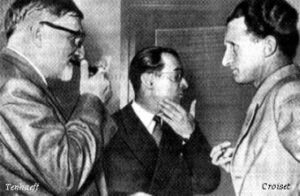
As I have demonstrated, at least to my own satisfaction, Tenhaeff’s reports – our principal source of information concerning Croiset – are utterly unreliable. It is therefore hazardous to suggest possible “naturalistic” explanations for any “facts” presented in those reports. One may easily waste one’s ingenuity on entirely spurious data. It is with this proviso that I will briefly offer a few conjectures about how the clairvoyant might have achieved what appear to be paranormal successes by perfectly normal means.
Croiset, a skilled hypnotist, was an expert muscle reader and a master of suggestive questioning. He was therefore well equipped for wresting shreds of information from unwitting clients and feeding these back as “telepathic” impressions.
It is possible that he occasionally resorted to cruder methods, such as using spies. In the pro-Croiset literature we find surprisingly little mention of the psychic’s “assistants” and “secretaries,” such as Dick West. Zorab (personal communication) has evidence that Croiset sometimes employed confederates in his experiments. Apparently the clairvoyant’s professional ethics were not such as to forbid a little trickery now and then.
Even more important, Croiset knew how to make friends and influence people. He maintained very cordial relations with a number of journalists and law officers. (Some policemen were patients of “Dr.” Croiset.) I do not need to point out the risks of such familiarity. Croiset was an engaging man who disarmed visitors with a convincing display of sincerity and simplicity. He was not the sort of person in whose company one felt the need to be on guard.
Discussion
The standard skeptical explanation for the alleged successes of psychic detectives is that these sensitives offer their consultants the verbal equivalent of a Rorschach test. Their statements are typically vague, rambling, and verbose. The accuracy of the readings is evaluated post factum: “Good sitters” retroactively interpret the ambiguous and often contradictory statements in such a way that they fit the true facts and obligingly forget the many details that were too wide of the mark. Complete failures are ignored or suppressed. The possibility that some of the paranormal information could have been acquired by normal means is quietly discounted. Occasional lucky guesses are enhanced by selective reporting and editorial embellishment.
The results of the present investigation suggest that this standard hypothesis does not need to be revised in order to explain the Croiset phenomenon. What always set Croiset apart was probably not the degree of his supposed paranormality but rather the success of the propagandistic efforts on his behalf. Unlike other psychics, Croiset had the extraordinary luck to find an impresario who enjoyed a fairly solid reputation as a scientist and scholar. The “Miracle Man from Holland” would never have achieved his status without the indefatigable help of Wilhelm Tenhaeff.
The fact that his mentor was an authentic university professor has always protected Croiset. Croiset was widely believed to be the most honest of men because Tenhaeff said he was. As I have suggested, the key to the Croiset mystery lay with Tenhaeff. The question now is: Why did Tenhaeff act as he did? Why risk an academic reputation by engaging in palpable fraud?
The answer, I think, can only be that Tenhaeff had to deceive and thought that he would be able to get away with it. Soon after he made Croiset’s acquaintance in 1947, the professor must have realized that the psychic’s successes in occult detection were highly ambiguous. Straight and full reports of the “police cases” would never convince those not committed to a strong prior belief in the paranormal.
Tenhaeff, whose ambition had always been to become the Sigmund Freud of psychical research, devised something he was pleased to label a “theory” that enabled him to explain all but the worst failures in terms of ESP. The red basting syringe is a typical example. Yet the professor needed at least a few ironclad proofs to underpin this odd theoretical structure. The extreme scarcity of authentic miracles forced him to fabricate them.
What now remains to be explained is how Wilhelm Tenhaeff got away with this game for so many years. I can only offer a few suggestions.
1. His status as an “official professor”: Tenhaeff was hailed as the first professor of parapsychology in history, and this carried much prestige. “He must be right or else they would not have appointed him, would they,” his admirers were wont to say when confronted with an unbeliever. For many, such considerations effectively settled the matter.
2. The confusion he created with his publications: To the delight of the true believers, who find obscurity sure proof of profundity, Tenhaeff’s writings are chaotic, verbose, and abstruse. A thick fog seems to exude from his books. Scanning these thousands of convoluted sentences for contradictions requires many hours of exceptionally dull work. Most skeptics sensibly give up after a few pages. I myself only embarked on this dreary task as the result of a challenge. After I had published some critical remarks on psychical research in 1978, local proponents defied me to come to terms with the best evidence they thought parapsychology had to offer: the “rigorously scientific work” of Wilhelm Tenhaeff.
Critical investigation is further complicated by the fact that the professor cleverly took advantage of the language barrier. The completely fraudulent versions of the “Boy on the Raft” and the Woudrichem cases were concocted for export only. To compensate, Tenhaeff occasionally did the reverse: in the German Zeitschrift fur Parapsychologie und Grenzgebiete der Psychologie (No. 4, 1980), I have shown how he dishonestly “edited” a report by Dr. Jule Eisenbud of an ambiguous success in a transatlantic ESP experiment with Croiset for home consumption in Holland.
3. The ambiguous feelings within the psi community toward cheating colleagues: The psi community has never completely freed itself from the pernicious idée fixe that overt criticism of a colleague may damage the cause and play into the hands of the enemies of parapsychology. Some psychical researchers began to suspect Tenhaeff long ago. Seldom, however, did they voice their doubts openly. And, when they did, some sociological mechanism seems to have prevented an adequate follow-up.
4. Tenhaeff’s mastery of propagandistic techniques: Tenhaeff has always been a master of propagandistic manipulation. He deftly used his excellent relations with the media to persuade a sizable segment of public opinion in Holland that he was a prophet of a new, nonmaterialistic science, who therefore had to suffer the irrational hatred of those whose world-view was threatened by the glorious discoveries of parapsychology. He never failed to remind his audiences of the religious implications of his work or to allude darkly to possible bolshevik influences in skeptical circles. His favorite trick was to tell the public that his critics were suffering from a Freudian complex and needed psychiatric treatment rather than to reply to their impertinent questions.
Ironically, Tenhaeff’s bizarre behavior convinced a number of skeptics that he was a gullible victim of a devious “psychic” rather than a deceiver in his own right. His apparent credulity served as camouflage for his dishonesty.
Conclusion
My purpose has not been to deny Croiset’s paranormal powers ex cathedra. Rather, I wanted to draw the reader’s attention to some false notes in the “psychic Mozart’s” scores, dissonants that seem to have escaped the notice of other biographers.
Of course if such a thing as ESP exists, it may well provide the most economical explanation for some of the coincidences that have been reported in connection with Gerard Croiset. On the other hand, it would be rash indeed to conclude the existence of a paranormal faculty on the basis of the Croiset material. If Croiset’s amazing talents of clairvoyance had been genuine, then why would Tenhaeff have felt the urge to manipulate reports and present them fraudulently as prize cases?
I certainly do not wish to be dogmatic about psychic detectives: positive evidence of a much stronger nature may yet turn up. Until it does, the “believer” is well advised not to base his belief on the “Psychic Who Never Disappointed.”
Acknowledgment
I am grateful to Mr. and Mrs. Ottervanger of Bussum, Holland, for having allowed me to make use of the extensive archives of the late Mr. Ph. B. Ottervanger.
References
Brink, F. Enige aspecten van de paragnosie in het Nederlandse Strafproces. Drukkerij Storm, Utrecht, 1958.
Brink, F. “Parapsychology and Criminal Investigation.” International Criminal Police Review 134 (January 1960).
Hansel, C. E. M. ESP: Scientific Evaluation. Scribner, New York, 1966, pp. 197-203.
Hansel, C. E. M. ESP and Parapsychology. Prometheus, Buffalo, N.Y. 1980, pp. 262-68.
Hoebens, P. H. “Vom Lob der Genauigkeit in der Parapsychologie.” Zeitschrift für Parapsychologie und Grenzgebiete der Psychologie 22, no. 4 (1980): 225-34.
Pelz, C. “Herr Croiset, Sie konnen nicht hellsehen.” Kosmos (1959/1960).
Pollack, Jack Harrison, Croiset the Clairvoyant: The Story of the Amazing Dutchman. Doubleday, Garden City, N.Y., 1964.
Roosmalen, Th. van. “Ervaringen met Paragnosten en die zich zo noemen.” Algemeen Politieblad 109 (1960): 3-9.
Tenhaeff, W. H. C. “Aid to the Police.” Tomorrow, Autumn 1953.
Tenhaeff, W. H. C. “De Paragnostische Begaafdheid van de Heer C.H.” Tijdschrift voor Parapsychologie 23, no. 2/3 (1955): 57-87.
Tenhaeff, W. H. C. Beschouwingen over het gebruik van Paragnosten. Bijleveld, Utrecht, 1957.
Tenhaeff, W. H. C. “The Employment of Paragnosts for Police Purposes.” Proceedings of the Parapsychological Institute of the State University of Utrecht, no. 1 (December 1960): 15-32.
Tenhaeff, W. H. C. Ontmoetingen met Paragnosten. Bijleveld, Utrecht, 1979.
Tenhaeff, W. H. C. “Der Paragnost.” Esotera 31, no. 9 (September 1980): 816-27.
Woudenberg, G. D.H. van. “Ervaringen met Paragnosten.” Algemeen Politieblad 113 (1964): 297-300.
Zorab, G. Review of Jack Harrison Pollack’s Croiset the Clairvoyant. Journal of the Society for Psychical Research 43 (1965): 209-12.

